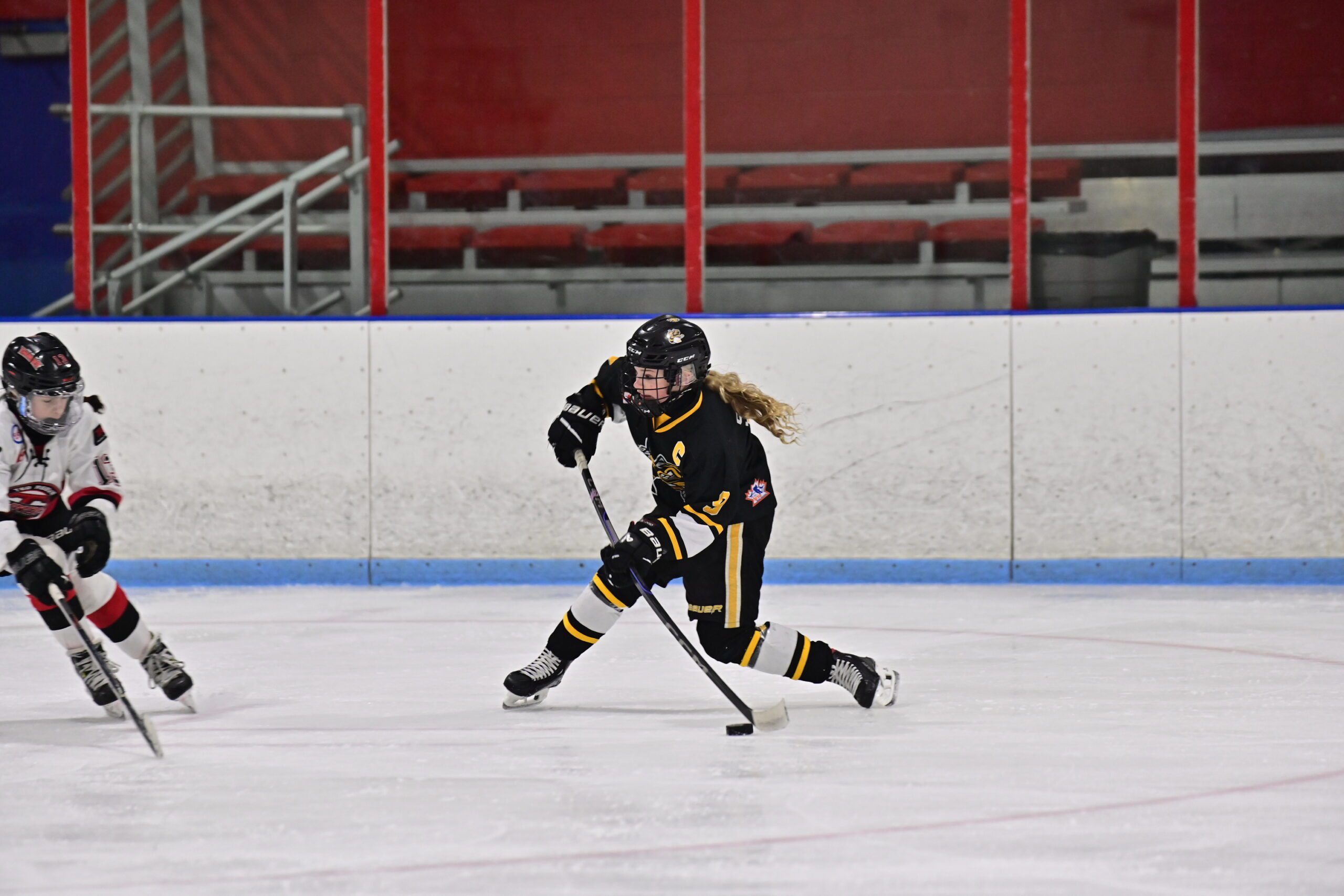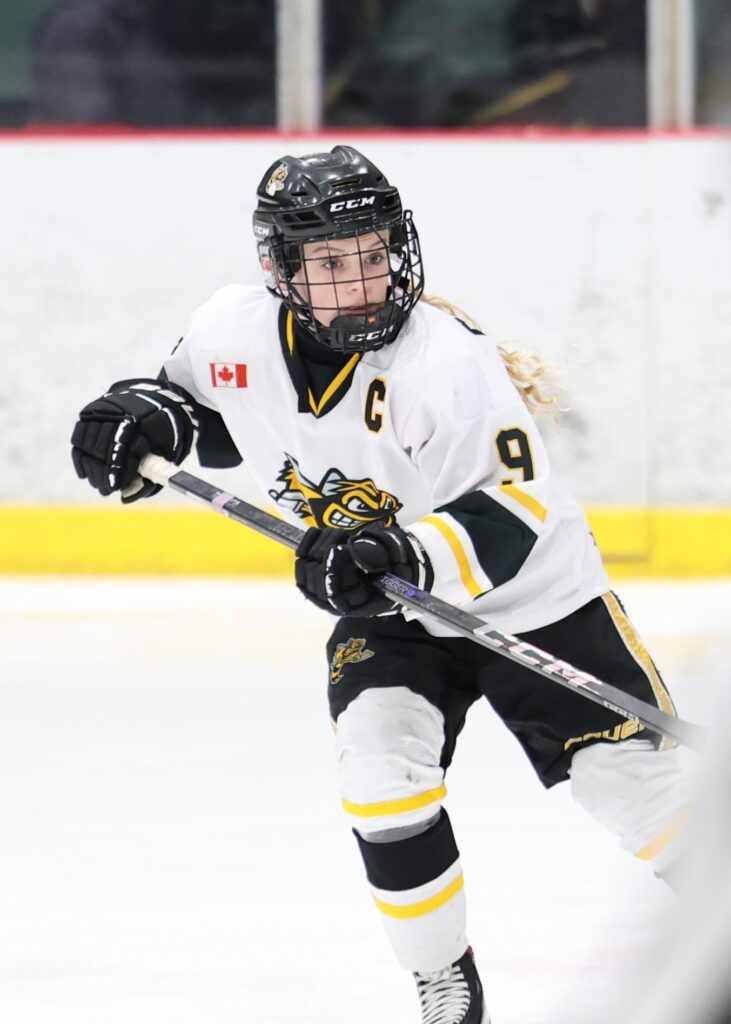
There is an assumption in sports that leadership is earned through tenure, skill, and a certain kind of presence—the intangible, ineffable quality that separates the good from the great. But every once in a while, a story emerges that challenges those assumptions and more. In Sarnia, Ontario, a 12-year-old girl named Laylah Stokes did just that when she was unanimously voted captain of her boys’ U13 AA hockey team. Not by the coaches. Not by the parents. But by her teammates—all 17 of them.
The moment Adam Pyne, head coach of the Sarnia Sting U13 AA boys’ hockey team, realized what had happened, he was stunned. He had expected Stokes, who plays centre on the team, to get votes. After all, she was a natural leader. But all 17? That was something different.
Pyne had wanted the vote to be organic, uninfluenced by coaches or parents. So, he handed out slips of paper in the locker room, asking each player to write down 4 names for captain. He then collected the ballots and, on his drive home, flipped through them absentmindedly. That’s when he noticed something remarkable.
“I saw Laylah’s name over and over,” he said. “At first, I wasn’t counting, but it was clear she was on every ballot.”
Her father, Shea, one of the assistant coaches, was in shock. He knew his daughter was respected, but this was something else entirely. As Pyne recounted, “He just kind of stopped talking—he was getting teary. It was one of those moments.”
When Stokes found out she had been chosen, her first reaction was pride. Her second was gratitude. “It was a proud moment,” she says. “It’s a good group of boys, and I’m really thankful that they voted for me.”
Some of those teammates have played alongside Stokes for years. Some are new to the team. But even those who had never laced up beside her before saw something undeniable in her. Leadership is not conferred. It is recognized. And her teammates recognized it in her.
The making of a leader
Leadership in sports is often framed in clichés: captains are vocal, they lead by example, they put the team before themselves. It’s typically tied to traditional notions of authority and presence. But true leadership goes beyond that—it’s built on trust, respect, and the ability to elevate those around you (Bandura & Kavussanu, 2018). Research on sport leadership suggests that the most effective captains aren’t just skilled players; they are individuals who foster team cohesion and motivation (Cotterill, 2017).
Pyne had spent 6 years coaching boys’ hockey, watching players cycle in and out, yet he had never seen a vote so decisive. Pyne says Stokes work ethic is the number one quality that makes her standout as a leader on the team. “She never takes a drill off, she’s extremely hyper focused,” Pyne said. “She’s fully focused on being the best she can be at all times, and that really endears her to the other players and coaches. And she’s not afraid to lead.”
These aspects of Stokes’s personality mirror the findings in sport leadership studies, which emphasize that commitment and effort often set respected captains apart—especially in mixed-gender settings, where performance and persistence can override gender biases (Musto, 2014; Cotterhill, 2017).
This, perhaps, is what set Stokes apart. Her presence wasn’t just about talent—though she had plenty of it—it was about effort. Every player on that team saw the work she put in. And when it came time to choose their leader, they didn’t hesitate.
READ MORE: Making #HERstory: Girls who play on boys’ teams and supporting the lone girl in sport
When asked what being captain means to her, Stokes is clear. “I think it’s about setting an example,” she says. “By how I play and then obviously before the game and off the ice as well.”
This idea—that leadership is more about action than words—is not a novel one. But in sports, it often takes an outsized personality to embody it. Stokes, by contrast, leads through quiet confidence and relentless work. “There are moments, like in warm-ups before the game, where I feel my leadership the most,” she explains. “Making sure everything flows smoothly, keeping the energy up.”
Stokes’s leadership has created a ripple effect beyond her own team. Each time they play against a new opponent, coaches and parents from the other team can’t help but ask about her. “Almost every single time we shake hands after a game, a coach asks, ‘Where did that girl come from?’” Pyne says. “She’s noticeable—not just because she’s smaller or has a ponytail sticking out of her helmet—but because she flies around the ice, making plays and leading the team.”
Why Laylah?
The answer to that question comes in layers. Stokes doesn’t just practice—she devours the game. She plays elite girls’ hockey in the spring, and has been invited to the play in the prestigious War for the Roses tournament with a team from Toronto, where the top girls’ teams from across North America compete. She chose to play boys’ hockey, not because she had to, but because she wanted to push herself.
Then, there’s her understanding of the game. In Stokes’s case, her work ethic and hockey sense come from home. “Definitely my parents,” she says. “Especially my dad. He’s explained a lot to me, helped me, given me advice.” Hockey families are a unique breed. They wake up before dawn for practices. They travel kilometres for games. They sacrifice weekends, holidays, and family time for the sport. And somewhere in that routine, a mindset is forged—the understanding that success is not given but earned.
“I’ve always had to work harder,” Stokes admits. “Not just because I’m a girl on a boys’ team, but because I’m not the biggest or the strongest. So, I have to prove that I deserve to be here.”
Her teammates have never questioned that. “They’ve always supported me,” she says. “On the ice and off it. They see me as a leader, and I really appreciate that.”


Stokes is more than just an inspirational figure; she’s a standout player. Though not necessarily the top goal-scorer, she is a playmaker, often quarterbacking her team’s offensive plays and ranking in the top 3 or 4 for points. Her skill and presence on the ice turn heads, and she’s proven time and again that she belongs at this level.
Despite the attention, Stokes’s teammates have come to see her as just another player—albeit a particularly talented and driven one. Initially, some of the boys were protective of her in physical games, but that changed as they saw her hold her own. “She can take care of herself,” says Pyne. “They treat her like any other teammate.”
Breaking the mold
There is an inevitable question: Has she faced challenges as a girl in a boys’ league?
Surprisingly, Stokes says no—at least, not from her own team. “The boys have been great. They’ve made everything easy for me.” This aligns with research indicating that when girls enter traditionally male-dominated sports, their greatest challenge is often external bias, not resistance from their teammates (Coletti et al., 2022).
Stokes’s impact goes beyond her team, sparking discussions about inclusivity in youth hockey. “Every time we play, there’s an impact—from parents, coaches, and players on the other team,” Pyne says.
While there has been the occasional comment from other teams, it’s nothing that has shaken her resolve. “A couple times, maybe,” she says. “But mostly, it’s been positive. After games, I’ve had players from the other teams come up and say really nice things.”
This is the paradox of breaking barriers. On the one hand, Stokes’s presence as a female captain on a boys’ team is extraordinary.
On the other, it is entirely ordinary to her teammates, who see her not as “the girl” but simply as their leader. Her leadership success backs research that highlights that when girls are given equal opportunities in male-dominated spaces, their abilities often speak for themselves, earning respect through performance rather than preconceived notions (Coletti et al., 2022).
What this says about the team
This story isn’t just about Stokes—it’s about the boys who chose her. It would be easy to assume that in a sport dominated by male culture, a girl leading a boys’ team would be met with resistance. But not here. These players didn’t just accept Stokes as their leader—they chose it.
There’s something profound about that. It suggests that when left to their own devices, these kids recognized merit before they recognized difference. In a world where leadership is often tied to superficial attributes—age, gender, seniority—these boys cut through all of that. They simply picked the best person for the job. Stokes story reflects what the research is showing—shifting cultural attitudes in youth sport, where younger athletes are increasingly valuing leadership traits over gender norms (Cruz & Kim, 2017).
Inspiring the next generation
What does she hope her leadership means for other girls who want to play competitive hockey?
“I hope they see that it’s possible,” she says. “That they can be leaders too, even on a boys’ team.”
Her younger sister, who also plays on a boys’ team, has been watching closely. “I hope it kind of inspires her too,” Stokes says. Research on role modeling in sports suggests that visibility matters—when girls see female leaders in male-dominated spaces, they are more likely to aspire to similar roles (Midgley et al., 2021; Kelly et al., 2023).
This is how change happens—not in sweeping, dramatic gestures, but in small, everyday moments. A little sister watching an older sister take the ice. A group of boys recognizing leadership where it exists, rather than where tradition tells them it should be. A captain who happens to be a girl, proving not just to others, but to herself, that she belongs.
The road ahead
At some point, Stokes will transition to girls’ hockey at a high level. That’s inevitable. But for now, with playoffs approaching, Stokes’s focus remains on the present. “That’s when leadership is really going to matter,” she says. “I want to finish the season strong with the boys.”
Beyond that, decisions loom. “Next year is a big question,” she admits. “Whether I stay in boys’ hockey or switch over to girls. It’s been a big discussion in our house.”
Regardless of what she chooses, her experience as captain on a boys’ team adds to a growing body of evidence that mixed-gender sport environments can be beneficial, both for individual athletes and for shifting broader attitudes about gender in sport (Hills et al., 2021).
But, Stokes’s journey has only just begun, and while it’s likely that she will eventually transition to a girls’ hockey team, there is something undeniably special about her role as captain of this boys’ team. Pyne, who hopes to coach the team again next year, is proud of what Stokes has accomplished, but he’s also hopeful for what’s to come for her.
In the world of youth sports, there’s often a lot of noise—the pressure to win, to be the loudest, the fastest, the most dominant. But every so often, a story emerges that reminds us that leadership doesn’t have to be loud. It doesn’t have to fit a mold. It just has to be real. And in the case of Laylah Stokes, real leadership is exactly what she provides.